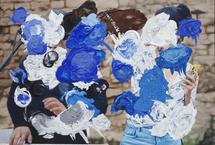This is the third solo exhibition by the artist Eduardo Sarabia (Los Angeles, 1976) at the Galería Javier López, and it expands on a conversation that began with his shows Intrahistorias (Intrahistories, 2019) and Expediciones (Expeditions, 2020), now focusing on his pictorial exploration in a selection of recent canvases and works on paper. In this new project, Sarabia continues to reflect on the journey, but here the travel is linked to a kind of introspection—a drive that relates to a search for the familiar, the warmth of the everyday, the importance of landscape, and reconnection with nature—as a form of resistance to lockdown and to everything that the pandemic has brought with it. Como la flor (Like the flower) is dedicated to memory and affection.
This series of paintings, on view for the first time, is part of an ongoing conceptual project, perhaps the most vulnerable, personal, and intimate in his body of work so far. He is interested in the way we process information, and a significant facet of his work is how one thing encompasses and embraces others, how something remains hidden in plain sight, but present as a trace. In the series Tainted, where faces are covered by layers of paint, concealment denies the viewer the image even though it is present from the beginning. In Painted Memories, he enlarges small snapshots of friends and collaborators that he has used as palettes—the figures dissolving into blotches of paint—transforming them into representations that resonate with our experience.
This practice starts with digitalizing personal photographs of friends, family, gatherings, and holidays, and enlarging them to emphasize the moment, the narrative, and the gesture. In these most recent works, we can distinguish beach scenes of clear skies, palm trees, cacti, and other plants, a silhouette outlined against the sunset. The portraits and landscapes that are or have been part of the artist’s life are interrupted by patches of vibrant colour, storm clouds, spirals and bursts of thickly applied, visceral colour, which in turn call to mind another time as they are linked to other works. The blotches that inhabit each image were the palette for another pictorial moment. Despite the erasure, the viewer can intuit the underlying everyday images captured by someone on the other side of a photographic lens, images that are at once familiar and alien, recognizable and oneiric, interweaving times, realities and fictions.
The autobiographical references are suppressed or veiled, and the distancing that Sarabia adopts allows for open interpretation by leaving space for the viewer’s perceptions and emotions. They are mysterious, seductive, and striking works, which seen from a distance tend towards abstraction and up close show a photorealist technique, thus emphasizing the importance of the pictorial exercise. Defined as a remarkable storyteller, Sarabia takes stories as his raw material. Through his travels, he analyses how our understanding of the world and the places we inhabit are constructed by means of facts and fictions. His personal visual code derives from his own life and experiences, but also from the fiction that accompanies the construction of the story.
As a way of articulating life experience and artistic production, Eduardo Sarabia’s work is specifically developed from other satellite projects. These include his participation in Blue Room and his work at contemporary art spaces such as The Mistake Room (Los Angeles), PAOS GDL, Museum of Contemporary Art Denver, at all of which he is an adviser; his bar Kissa (Gdl), catalyst of encounters, and his Tequila Sarabia and Mezcal La Otra; the fashion and design project Oro + Oro; the treasure hunt; and his association with the Mexican baseball team the Mariachis de Guadalajara. All these projects allow him to move through and explore different formulas for creating links, for constructing stories, and for socio-cultural investigation. Eduardo Sarabia lives and works in Guadalajara (Mexico).
